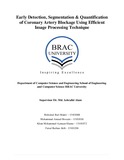| dc.contributor.advisor | Alam, Dr. Md. Ashraful | |
| dc.contributor.author | Shakir, Mohsinul Bari | |
| dc.contributor.author | Hossain, Mohammad Amzad | |
| dc.contributor.author | Shams, Khan Mohammad Aymaan | |
| dc.contributor.author | Akib, Faisal Raihan | |
| dc.date.accessioned | 2018-02-18T05:20:57Z | |
| dc.date.available | 2018-02-18T05:20:57Z | |
| dc.date.copyright | 2017 | |
| dc.date.issued | 2017 | |
| dc.identifier.other | ID 13101068 | |
| dc.identifier.other | ID 13101016 | |
| dc.identifier.other | ID 13101072 | |
| dc.identifier.other | ID 13101204 | |
| dc.identifier.uri | http://hdl.handle.net/10361/9495 | |
| dc.description | This thesis report is submitted in partial fulfilment of the requirements for the degree of Bachelor of Science in Computer Science and Engineering, 2017. | en_US |
| dc.description | Cataloged from PDF version of thesis report. | |
| dc.description | Includes bibliographical references (pages 50-53). | |
| dc.description.abstract | Advancements in computing speed and power have made revolutionary changes in medical science practices and this is no different for cardiology. Such advancements in computer sciences have made the existing medical tests of heart into being. These tests are: ECG, CTA, & Echocardiogram. CTA (Computed Tomography Angiography) is a widely used imaging technique to visualize arterial and venous vessels throughout the body. In clinical practice, the analysis mainly relies on visual inspection or manual measurements by experienced cardiologists. The proposed method aims towards a full automation of the detection of coronary artery blockage through some image processing techniques so that the system does not have to rely on any human’s inspection. The goal of the research is to implement the proposed image processing techniques so that the system can detect the narrowing area of the wall of coronary arteries due to the condensation of different artery blocking agents. This detection is crucial for further analysis of the heart. The research suggests that the system will require a 64-slice CTA image as input. After the acquisition of the desired input image, it will go through several steps to determine the region of interest. This research proposes a two stage approach that includes the pre-processing stage and decision stage. The pre-processing stage involves common image processing strategies while the decision stage involves the extraction and calculation of two feature ratios to finally determine the intended result. In order to get more insights of the subject of these examinations, this research has proposed the use of an algorithm to create a 3-D model. Moreover, the system to work more precisely and effectively, use of several techniques have been suggested including parallel processing with shared memory allocation between the CPU and the GPU. Using the parallel processing technique not only makes the whole process at least 7 times faster, but also helps several stages of the process work more effectively. | en_US |
| dc.description.statementofresponsibility | Mohsinul Bari Shakir | |
| dc.description.statementofresponsibility | Mohammad Amzad Hossain | |
| dc.description.statementofresponsibility | Khan Mohammad Aymaan Shams | |
| dc.description.statementofresponsibility | Faisal Raihan Akib | |
| dc.format.extent | 53 pages | |
| dc.language.iso | en | en_US |
| dc.publisher | BRAC University | en_US |
| dc.rights | BRAC University thesis reports are protected by copyright. They may be viewed from this source for any purpose, but reproduction or distribution in any format is prohibited without written permission. | |
| dc.subject | Segmentation | en_US |
| dc.subject | Quantification | en_US |
| dc.subject | Artery blockage | en_US |
| dc.subject | Coronary blockage | en_US |
| dc.subject | Image processing technique | |
| dc.title | Early detection, segmentation and quantification of coronary artery blockage using efficient image processing technique | en_US |
| dc.type | Thesis | en_US |
| dc.contributor.department | Department of Computer Science and Engineering, BRAC University | |
| dc.description.degree | Department of Computer Science and Engineering, BRAC University. | |
| dc.description.degree | B. Computer Science and Engineering | |

